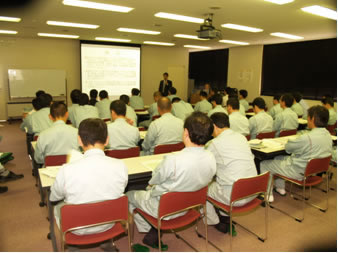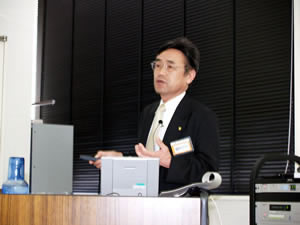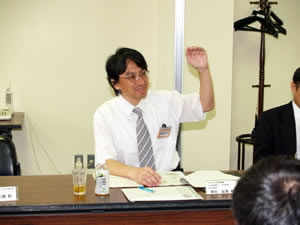|
|
 |
| The 84th Safety Caravan was held at Kumatori Works of Nuclear Fuel Industries, Ltd. in Kumatori-cho, Sennan-gun, Osaka Prefecture on July 5, 2006 |
|
| Safety Presentation
|

|
|
During the safety presentation
|
Forty-nine employees of Kumatori Works of Nuclear Fuel Industries, Ltd. attended the Safety Presentation.
The presentation started off with Mr. Shinsuke Matsumoto, Manager of the Kumatori Works, Nuclear Fuel Industries, Ltd. "Some time ago, we were warned in a speech given by the Safety Committee chairman against security quality activities that become mere facades. If we make endeavors from only our own perspective, there is no way to avoid deteriorating and becoming a mere facade. Given this factor, we think that it is possible to avoid turning into such a facade by taking in new safety research opinions from the outside and examples of good practices of other companies introduced by NSnet Division into our activities, and by spiraling up through the application of stimulus and carrying out the PDCA cycle.
|
"Japan Nuclear Technology Institute (JANTI) carries out peer reviews, safety caravans and safety climate surveys on our company's behalf. In the previous peer review conducted in January 2004, there were three items earmarked for improvement. One of those was a recommendation to actively engage in information disclosure, which has been furthered by electric power companies. And then, a proposal was made for creating such a framework. Having received such a proposal, our company also felt the need for information disclosure, and together with three fuel processing manufacturers, efforts began in the disclosure of information, and the operating status, including information about troubles, was published on our website. It just so happened at the time, that when we received an inquiry from the Nuclear and Industrial Safety Agency (NISA) as to what we were doing in the way of information disclosure, we were just in the process of making preparations for information disclosure as a result of having received the suggestion for improvement, and so we were able to provide an excellent reply. We believe that it is because on-site free exchanges of opinions are made possible at peer reviews, and because the peer reviews are not of an auditing nature, that is why we were able to respond to such a proposal.
"Through the new opinions and the stimulus received from the Safety Presentation and the Information Exchange Session at today's Safety Caravan, we hope to make efforts to raise the level of safety climate higher and higher. We look forward to your guidance." With this, Mr. Matsumoto concluded his greetings.
After the salutation, JANTI introduced its action policies and the state of activities of NSnet Division. Following this, Mr. Seiichi Yoshimura , Deputy Manager of the Human Factors Research Center , Socio-economic Research Center of the Central Research Institute of Electric Power Industry (CRIEPI) delivered a speech entitled "Safety measures and understanding of the human factor." |
Lecture highlights |

|
|
Mr.Seiichi Yoshimura
|
Recently a number of major accidents and troubles have become conspicuous, and against this backdrop, the human factor plays a large role. Machinery systems such as power plants can not run without the intervention of humans. In this sense, it is no exaggeration to say that the human factor is the essence of preventing accidents and troubles.
So then, what is the human factor? On the academic level there are numerous definitions, but putting it simply, it can be perceived as "internal and external factors that exert influence human activities." When we think about it this way, human error (deviation from criteria) is the result of human actions, whereas the human factor is the various factors upstream from this. In other words, the analysis of the human factor is the job of seeking out the cause (human factor) from the result (human error: behavior that leads to accidents and troubles). Therefore, measures (prevention of recurrence and proactive measures) should be implemented in regards to the factors that have been thusly clarified.
The human factor encompasses a wide general concept, and as one of the points, it is extremely important to understand human nature. That is, while the worker him/herself ought to be cautious, at the same time the supervisors need to know this. The reason for this is that the method of supervising the work (working hours, work performed by one person or two persons, work instructions and the like) as well, when we think in terms of safety, has a close connection with human nature. Also, work performed by a team is normally more reliable than in the case of one single person, but there are times when team judgment can take a wrong turn (going along with the crowd). This is a part of collective and social human nature, and not only supervisors, but a matter also affecting the top management (for instance, management judgment). Recently, observance of regulations and laws is becoming an important theme. Looking at this on the level of the actual worksite, this turns into violations of the regulations (taking shortcuts). Failure to abide by regulations becomes a world of "I know it, but..." and we may think of this as the result of human instinct to seek the easy way of doing things. Accordingly, in order to avoid this, we have to take the regulations that are unreasonable and those that do not fit the actual circumstances and unify them and put them into the proper perspective.
Thus, workers, supervisors and top management have got to understand the human factor at each respective level, and materialize workplace safety. Up until now, there has been a tendency of thinking that only the on-site workers needed to understand the human factor, but in riding the wave of this Safety Caravan and with the idea that it is important for the supervisory level and top management level to understand the human factor, I have given it the subtitle of "from plant floor to top management." Especially, when thinking about countermeasures, there are accompanying expenses, and so it can be said that the role of supervisors and top management is a major one. Also, when we think of the company's productivity, safety can not be ignored.
Considering the virtual organizational changes in the interval between productivity versus safety, according to James Reason in his book "Organizational Accident," JUSE Press, Ltd., 1999 (edited by Shiomi and translated by Takano and Saso), since organizations generally place importance on productivity, safety declines, leading to accidents. When that happens, there is a change of direction toward placing importance on safety, but then, since productivity does not rise, eventually, there is another change of course toward placing importance on productivity, leading to more accidents. The thinking is that this sort of process is repeated over and over again. Accordingly with this way of thinking, in order to raise productivity, safety also must be raised. This is the important point.
I hope all workers in attendance here today will correctly understand the human factor. This is because it will be useful in preserving your own safety. And for those of you who are in the supervisory class and top management class, recognizing this importance, I hope you will make it your aim to materialize a workplace environment where workers can work safely and comfortably. By doing so, accidents and trouble caused by the human factor will decline, and productivity should rise on its own accord. Perhaps recognition of this is what is needed now more than anything else.
This sums up the precious speech that we heard.
|
After the presentation, the following comments were made.
•It used to seem as though the human factor was a question of personal characteristics and propensity. However, it was demonstrated in an easy-to-understand way that by analyzing the backdrop and actions taken, the problem becomes deeper and wider in scope. In order to be able to explain this to other people, I hope to develop an appreciation of this while recalling the lecture.
•It was an excellent lecture. In the lectures I have attended in the past on topics such as human error and so forth, usually the talks were pretty much cut and dried on a theoretical basis, but today's talk consisted of a balanced blend of theory and real events, making it much easier for us to understand. Also, the materials used in the lecture were used ingenuously, there is no doubt that today's lecture will remain in my memory far beyond the Ebbinghaus forgetting curve.
• The topic provided food for thought more than any other similarly themed education I have ever experienced. Especially, it was possible to confirm based on actual precedents that these accidents occurred because of the physiological and psychological characteristics of humans. With respect to workplace safety, it is my intention to introduce these topics into our workplace and make the process that leads to accidents (human error) understood by others.
I became aware that as nuclear power is a leading edge technology, human engineering ought to be leading edge as well.
|
Safety information exchange session |

|
|
Mr.Norio Nomura
|
(1) Explanation of endeavors and exchange of opinions
We were honored by the presence at this safety information exchange session of Mr. Norio Nomura , Manager of the Safety Measures Department , Safety Management Division of the Japan Atomic Energy Agency (JAEA) Oarai Engineering Center who gave a detailed explanation of the risk assessment endeavors at Oarai Engineering Center .
Also, Mr. Yoshimitsu Sakagami, Manager in charge of Safety and Health, Business Administration Division of Nuclear Fuel Industries, Ltd. , who explained about the safety assurance endeavors at Kumatori Works of Nuclear Fuel Industries, Ltd., and Mr. Yutaka Toba, Business Administration Division Manager , who explained about endeavors toward fomenting safety culture through "interaction with top management."
After these talks, information and opinions were exchanged on the above-mentioned endeavors and activities.
(2) Other
The NSnet Division explained about its nuclear power safety culture fomenting database and information and the like.
|
|
|







